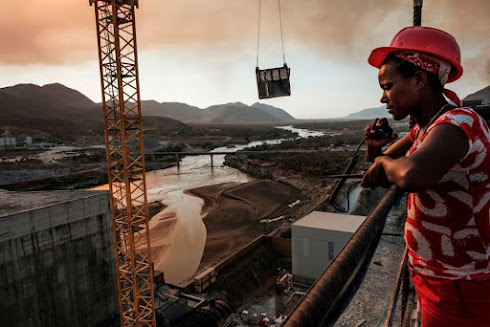Dam Discourse II: The Aswan High Dam
As discussed in the previous entry, dams face the dichotomy of being exceptional engineering achievements, yet significant environmental and social threats. While the GERD has the most recent publicity in the Nile basin as a significant dam project, the Egyptian Aswan High Dam (AHD) must not be disregarded. Until the GERD, the AHD was the most ambitious infrastructure project in the Nile Basin, cementing Egypt's status as the dominant riparian. In the context of conflict in the region, there is much the three riparians of GERD discourse can learn from, especially Egypt worrying about threats to its physical water flow.
The location of the AHD in Egypt (Source)
"Truly Egypt is the Nile and the Nile is Egypt" (Source)
Whenever we think about Egypt, we cannot see it as its outline on a political map, you have to realise 95% of its 105 million population live along the length of Nile. Thus, controlling the waterscape is vital for its functions as a state.
We can break the primary motivation's the AHD into three. One, regulating the flow of the river to ensure water supply during significant low flow to in the dry season and reduce flooding in the wet season. Two the dam would facilitate provide long-term storage that could allow agriculture to expand in the face of a growing population. Three, like the GERD, the AHD would generate electricity, now supplying 45% of Egypt's energy. As such, the scope of the AHD is huge standing at 3,830 m wide and has the capacity to release 11,000 mᶟ of water per second!
On the surface, the project has panned out successfully. Up to 3.4 million hectares have benefited from irrigation irrigated by the Nile, increasing Egypt's agricultural output and desert greening, changing the agricultural pattern of the country to intensive and continuous cultivation, facilitating the growth of more cash and export crops. Nile navigation has improved and tourism on the Nile has increased (the dam itself is a tourist attraction, as well as the many cruise ship hotels), diversifying the Egyptian economy outside of agriculture. Fishing behind the dam has also increased, with the reservoir created by the dam, Lake Nasar, supporting many fish farms.
Controlling the river flow by building a dam makes sense from a political standpoint, Egypt could have more sustained agriculture for its growing population and a consistent supply of clean energy. But, the AHD, like all dams has come at a severe cost.
Social development gains to a majority come with development deficits to a significant minority. Large numbers of ethnic Nubians who had inhabited the area behind the dam, were displaced from their homes due to the extensive flooding behind the dam required. 100,000 in Egypt, but also an estimated 500,000 had to be resettled across the border in Sudan. The resettlement schemes in Egypt meant that Nubian communities became scattered, having to re-establish their livelihoods.
Agriculturally there have been negative impacts too. The Nile delta (Egypt's richest agricultural region) is eroding at 25mm a year from reduction in sediment deposits, which while small, when compounded over a number of years is a real threat to the Egyptian economy and millions of livelihoods. Further, from the reduction in soil nutrients (becoming trapped behind the dam with the sediment), $100 million worth of artificial fertilisers have to be used every year and increasing the reliance on food imports, something the project was meant to reduce.
And that increase in fish stocks in Lake Nasar? That has come at the cost of the rest of the country's fish reduced the amount of fish being caught. Sardine yields in particular reduced by 95%, also from the lack of silt downstream.
So how does this apply to lessons for dealing with the GERD? The dam is being completed soon, so there is little Egypt can do to advise against it. Egypt is however, in a good position to aid Ethiopia in regard to lessons around filling and managing the impacts of the dam. Further, Egypt should respect the political aims Ethiopia has for building such a large dam in the first place, considering it implied the same logic during its the AHD construction. However, you can also see why Egypt is nervous, considering the significant consequences it has inflicted on itself from constructing a large dam on the Nile.

You can understand why Egypt is particularly concerned about the GERD when you see the extent of desert against the small strip of agricultural land. (Source)
For more information on the AHD (Source)






Comments
Post a Comment